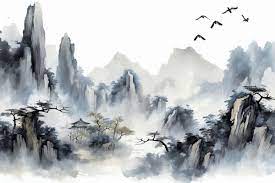The Enchanting World of Chinese Painting: A Timeless Art Form
The Timeless Beauty of Chinese Painting
Chinese painting, with its rich history spanning thousands of years, is a true reflection of the country’s cultural heritage and artistic prowess. Characterised by its unique techniques, symbolism, and aesthetics, Chinese painting has captivated audiences around the world with its timeless beauty and profound meaning.
The Origins of Chinese Painting
The roots of Chinese painting can be traced back to ancient times, with early examples found on pottery vessels dating back to the Neolithic period. Over the centuries, Chinese artists developed a distinctive style that focused on capturing the essence of nature, as well as expressing philosophical and spiritual concepts through their art.
Techniques and Styles
Chinese painting encompasses a wide range of styles and techniques, including ink wash painting (shui-mo hua) and meticulous brushwork (gongbi). Artists often use traditional materials such as ink sticks, brushes made from animal hair, and rice paper to create intricate landscapes, portraits, and calligraphy.
Symbolism and Meaning
Symbolism plays a significant role in Chinese painting, with each element carrying deeper meanings related to nature, mythology, or philosophical ideas. For example, the use of certain colours or motifs may represent prosperity, longevity, or harmony in Chinese culture.
Influence on Western Art
Chinese painting has had a profound influence on Western art movements such as Impressionism and Abstract Expressionism. Artists like Vincent van Gogh and Claude Monet were inspired by the simplicity and elegance of Chinese brushwork, incorporating elements of it into their own works.
The Legacy of Chinese Painting
Today, Chinese painting continues to evolve while staying true to its traditional roots. Contemporary artists are experimenting with new techniques and materials while honouring the legacy of their predecessors. The beauty and cultural significance of Chinese painting remain as relevant today as they were centuries ago.
Through its masterful use of brushwork, symbolism, and storytelling, Chinese painting offers a window into a world where art is not just a visual representation but a reflection of the artist’s soul.
Exploring the Rich Heritage and Influence of Chinese Painting: Symbolism, Brushwork, and Nature
- 1. Rich Cultural Heritage
- 2. Symbolism and Meaning
- 3. Mastery of Brushwork
- 4. Connection to Nature
- 5. Influence on Artistic Movements
Challenges of Chinese Painting: Limited Colours, Complex Symbolism, and Time-Intensive Techniques
1. Rich Cultural Heritage
Chinese painting boasts a rich cultural heritage that is deeply intertwined with China’s extensive history and traditional customs. This art form provides a window into the artistic legacy of ancient China, showcasing the profound influence of centuries-old traditions on contemporary artworks. Through Chinese painting, viewers can immerse themselves in the vibrant tapestry of Chinese culture, gaining insights into the values, beliefs, and aesthetics that have shaped the artistic landscape of this dynamic nation for generations.
2. Symbolism and Meaning
In Chinese painting, the intricate use of symbolism and meaning adds depth and complexity to each stroke and motif. This aspect of Chinese artistry enables multiple layers of interpretation and storytelling to unfold within the artwork, inviting viewers to delve deeper into the cultural, philosophical, and spiritual significance embedded in every brushstroke. The rich symbolism in Chinese painting not only enhances the visual appeal but also serves as a gateway to a world where each element conveys a profound narrative that transcends mere aesthetics.
3. Mastery of Brushwork
Chinese artists are celebrated for their exceptional mastery of brushwork techniques, a skill that sets them apart in the world of art. Through their precise and skilful use of brushes, Chinese artists can bring intricate details and expressive forms to life on paper or silk. The ability to convey emotions and stories through each brushstroke showcases the unparalleled talent and dedication of these artists, highlighting the beauty and depth that can be achieved through the art of Chinese painting.
4. Connection to Nature
Chinese painting’s connection to nature is a profound aspect that sets it apart from other artistic traditions. By focusing on capturing the beauty of the natural world, Chinese artists showcase a deep reverence for the environment and its intrinsic connection to humanity. Through delicate brushwork and symbolic imagery, Chinese painting embodies a harmonious relationship with nature, inviting viewers to appreciate and contemplate the serene beauty that surrounds us.
5. Influence on Artistic Movements
Chinese painting has inspired artists around the world and influenced various art movements, showcasing its enduring relevance and impact on global art history. The intricate techniques, symbolic depth, and philosophical underpinnings of Chinese painting have served as a wellspring of creativity for artists seeking new forms of expression. From the delicate brushwork to the profound symbolism embedded in each stroke, Chinese painting continues to shape artistic movements and inspire creativity across cultures, highlighting its timeless influence on the evolution of art worldwide.
Limited colour palette
One drawback of Chinese painting is its limited colour palette, often characterised by a restrained use of hues. This minimalist approach may not resonate with individuals seeking artworks with vibrant and diverse colours. While the subdued palette in Chinese painting conveys a sense of harmony and tranquillity, it may not capture the attention of those who appreciate a more dynamic and colourful visual experience in art.
Complex symbolism
The complexity of symbolism in Chinese painting can present a significant challenge for viewers who are not well-versed in the cultural references and meanings embedded within each element. The intricate symbolism, deeply rooted in Chinese history, mythology, and philosophy, may require a deeper understanding of the context to fully appreciate the nuances and messages conveyed by the artist. Without this background knowledge, viewers may struggle to grasp the intended significance behind the symbols, potentially limiting their ability to engage with and interpret the artwork effectively.
Time-consuming process
The time-consuming process of Chinese painting poses a significant challenge to aspiring artists due to the intricate brushwork and techniques involved. Mastering this art form demands a great deal of patience and dedication, as every stroke and detail must be carefully executed to achieve the desired effect. The slow and deliberate nature of Chinese painting can be both rewarding and frustrating for artists, highlighting the importance of perseverance and commitment in honing this traditional craft.


